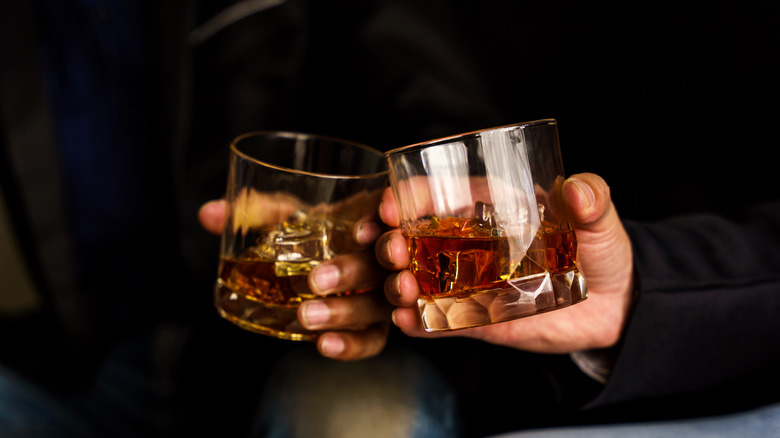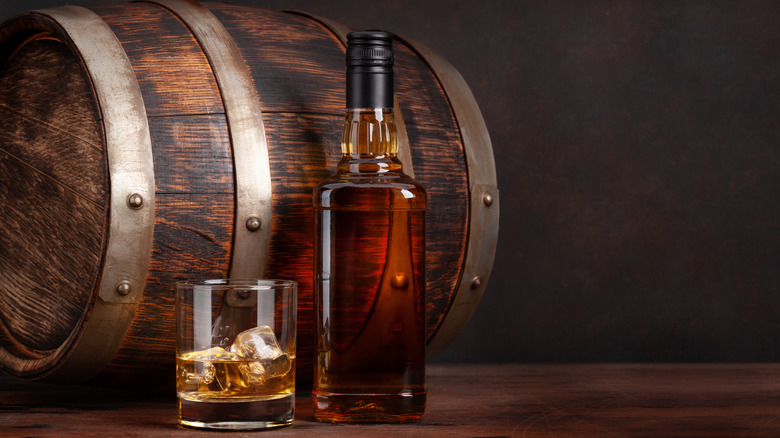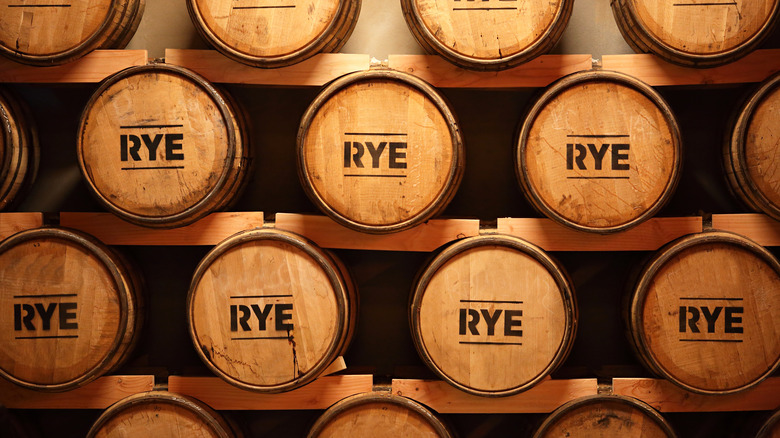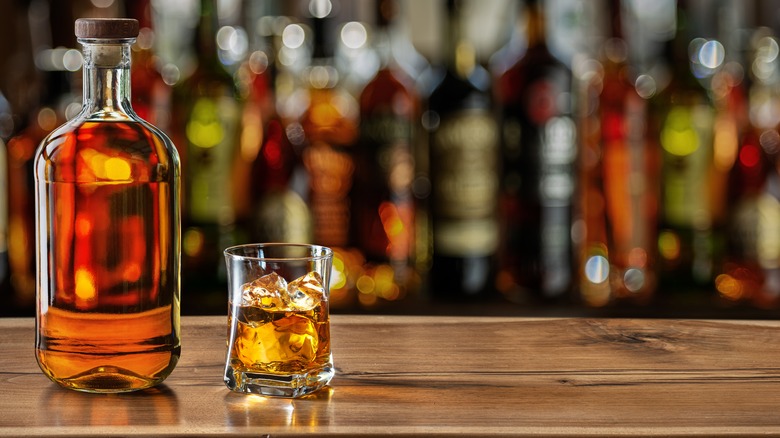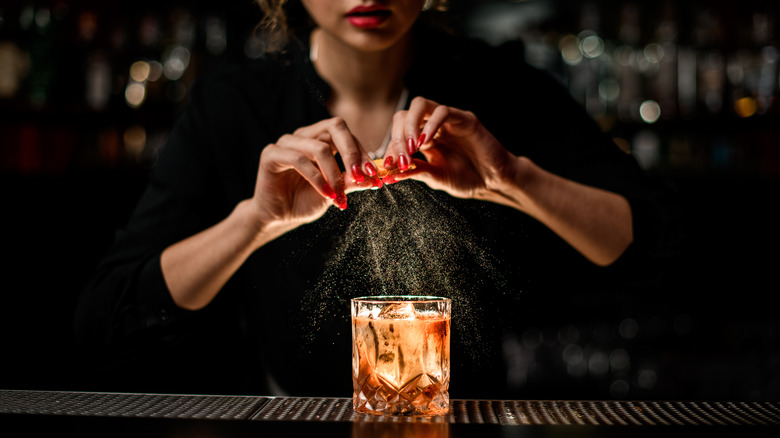What's The Difference Between Bourbon And Rye?
When it comes to spirit types, whiskey's the most popular pick in most U.S. states. With its storied legacy and beloved flavor, it's hardly a surprise. Wondrously malleable, the brown booze does well for sipping or mixing. Plus, it can range anywhere from an affordable handle to some of the world's most expensive alcohol.
There are six types of regulated whiskeys in the U.S., but two varieties especially stand out: rye and bourbon. Intertwined with Kentucky distilling, they're as all-American as whiskey gets — a must-have on the liquor shelf. The two style's production methods are remarkably similar.
It all starts with a mash bill, a blend of grains that are whiskey's core. The mix is ground and mixed with water, along with some mash from the previous batch. After yeast is introduced, the fermented result is usually double-distilled, although specifics vary by producer. Finally comes another crucial step for the liquor's character — the barrel-aging process. So with such similarities, what factors distinguish rye and bourbon? Let's dive into the specifics.
What is bourbon?
Few spirits are more quintessentially American than bourbon — in fact, it has to be produced in the U.S. To ensure consistency, the liquor carries a specific set of regulations overseen by the U.S. federal government. Its most defining quality is the components of the mash. U.S. law dictates bourbon's base must be at least 51% corn, with many producers using up to 70%. Corn is filled with sugars, so the higher the ratio, the sweeter the resulting bourbon. To round out the mash, malted barley, wheat, and rye are also added to the mix.
The produced alcohol — always additive-free — has additional requirements. The mashed distillation caps at 160 proof, and what goes into the barrel must be no more than 125 proof. Once bottled, the bourbon needs to be at least 80 proof. And finally, the liquor can only be aged in charred oak barrels. Most bourbons spend four years resting — anything shorter must be explicitly noted on the bottle.
Typically, the longer the age of the bourbon, the more complex — although, of course, it depends on the deftness of the distiller. Today, 95% of bourbon is produced in Kentucky, where natural conditions and heritage promote the spirit.
What is rye?
Just like with bourbon, the U.S. government has specific regulations defining rye whiskey. However, the spirit can hail from a larger assortment of nations — where it might have different regulations. To be sold as rye in the U.S., many requirements overlap with bourbon. The spirit's capped at 160 proof of mashed distillation and must be over 80 proof when bottled. The aging vessel is the same — new charred oak barrels.
The key difference is the mash makeup. As per its name, this whiskey variant necessitates at least a 51% rye makeup in the mash. There's a lot of variation in the constituents — many big-name brands craft liquor right off the cut-off, while others go all the way up to 100% rye.
The result is an earthy liquor with more of a kick than bourbon. And although much of modern American rye whiskey production is also clustered around Kentucky, it's historically had more regional variations. Especially before Prohibition, substyles like spicy Pennsylvania whiskey or floral Maryland rye were proudly distilled. Over the decades, many producers shuttered their doors; however, a new wave of craft distillers is once again showcasing the style's variability.
Flavor differences between rye and bourbon
The mash's prevailing component — corn vs. rye — being only 51% may not seem like a prominent distinction. However, it inspires quite a bit of deviation between the two spirits. Their flavor palettes are easily delineated, with bourbon known to be smoother, hence its slightly greater popularity. The corn imparts more sweetness, as well as a more buttery texture that makes it easier to sip. In a well-crafted bourbon, flavors of caramel, dark fruit, and a hint of spice — all underlaid on a sweet backbone — are the most prominent flavors.
Rye whiskey covers a greater range of resultant flavors. The ratio of ingredients in the mash is more variable, as are the locations of producers. Plus, it can legally incorporate up to 2.5% of additives, while bourbon can only be cut with water. Such a malleability means rye can range from a sweet corn-heavy spirit that resembles bourbon to a 100% rye liquor that delivers a strong kick. Expect anything from vanilla and herbal notes to earthy flavors or a strong hit of pepper, nutmeg, and cinnamon spice. Before selecting a handle, inspect the mash constituents and aging process to get an idea of the taste.
When to use bourbon or rye in a cocktail
With such a difference in flavor, it's no surprise that each style creates a different range of cocktails, too. Let's start with the most stored whiskey cocktail of them all — the old-fashioned. In the original 19th-century rendition, the sling reached for rye, but only since bourbon wasn't widespread yet. Nowadays, bartenders incorporate either spirit or sometimes a mixture of the two. For a more alcohol-forward old-fashioned, reach for rye, while bourbon creates an equally delicious, albeit sweeter rendition.
Rye's the traditional choice in many classic cocktails, but such recipes are malleable. Everything from Sazeracs to Manhtattan's and whiskey sours can be constructed with bourbon. Just make sure to adjust the ratio of the sugar in the drink — adding less to compensate for bourbon's sweetness. And if your aim is to craft a drink with a bite, it's best to remain true to original recipes and stick to rye.
Bourbon shines in sweeter cocktails with fruits and spice. Its smoother body amplifies other components, crafting a sum greater than its parts. When looking to add a whiskey note to a Moscow mule or margarita, bourbon's a great candidate.
